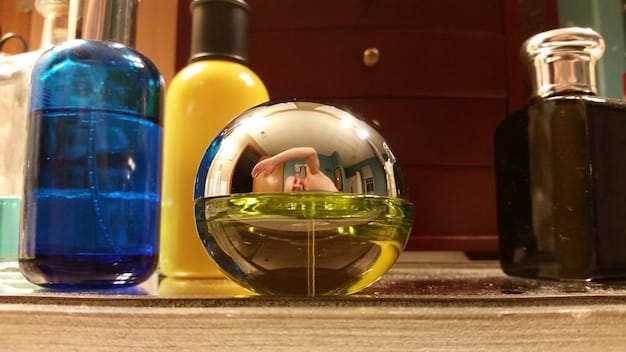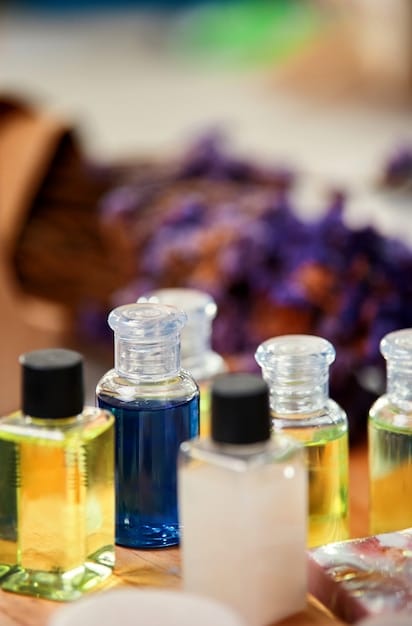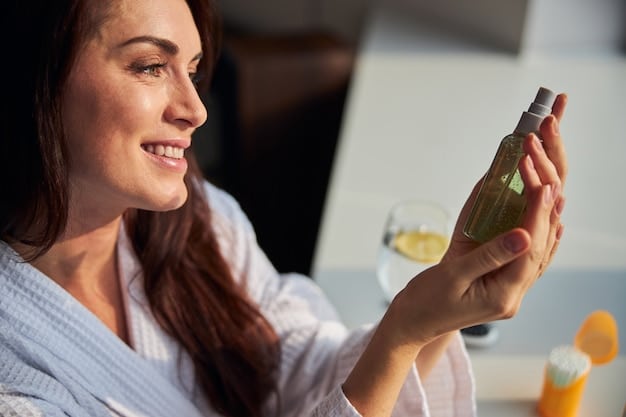Decoding Perfume Concentrations: Eau de Parfum vs Eau de Toilette in Germany

Advertisements
Decoding Perfume Concentrations: Eau de Parfum vs. Eau de Toilette in the German Market reveals key differences in fragrance concentration, longevity, and price, guiding German consumers to make informed decisions based on their preferences and needs.
Understanding perfume concentrations is essential for anyone looking to purchase a fragrance. In the German market, where consumer preferences are diverse and sophisticated, knowing the difference between Eau de Parfum (EdP) and Eau de Toilette (EdT) can significantly impact your buying decision. This guide explores the nuances of these two popular concentrations, helping you choose the perfect scent for your needs.
Advertisements
Decoding Perfume Concentrations: A German Market Guide
When navigating the fragrance aisle, whether online or in a German department store, you’ll encounter various terms indicating concentration. Eau de Parfum (EdP) and Eau de Toilette (EdT) are among the most common. But what do these terms really mean, and how do they affect your fragrance experience?
Understanding these distinctions is not just about knowing the lingo; it’s about making an informed choice that aligns with your lifestyle, preferences, and budget.
Advertisements
What is Perfume Concentration?
Perfume concentration refers to the percentage of perfume oil in a fragrance. This percentage determines the intensity, longevity, and overall character of the scent. Higher concentrations generally mean a stronger, longer-lasting fragrance, while lower concentrations are lighter and more subtle.
Different concentrations cater to different needs and preferences. Understanding these differences will help you find the perfect scent for any occasion.
Key Factors Influencing Concentration
Several factors influence perfume concentration, including the types of solvents used, the quality of perfume oils, and the specific formulation techniques employed by the perfumer.
- Solvent Quality: High-quality solvents ensure the perfume oils are properly dissolved, creating a smooth and consistent fragrance experience.
- Oil Quality: The purity and quality of the perfume oils directly impact the intensity and complexity of the scent.
- Formulation: Expert formulation techniques ensure the fragrance develops harmoniously and lasts as intended.
Understanding these elements helps you grasp the overall quality and value of a fragrance.

Eau de Parfum (EdP): The Essence of Longevity
Eau de Parfum, often abbreviated as EdP, contains a higher concentration of perfume oils compared to Eau de Toilette. This results in a more intense and longer-lasting fragrance experience. EdP is a popular choice for those who want a scent that lingers throughout the day or evening.
EdP generally offers a richer and more complex scent profile, making it a favorite among fragrance enthusiasts.
Characteristics of Eau de Parfum
Eau de Parfum has several distinguishing characteristics that set it apart from other fragrance concentrations. These include a higher concentration of perfume oils, greater longevity, and a more pronounced scent profile.
- Concentration: Typically contains 15-20% perfume oil.
- Longevity: Lasts approximately 4-5 hours on the skin.
- Scent Profile: Offers a richer, more complex scent experience.
Its durability and intensity make it suitable for various occasions, from everyday wear to special events.
Eau de Toilette (EdT): Light and Refreshing
Eau de Toilette, or EdT, is a lighter fragrance concentration that is ideal for everyday wear, particularly in warmer months. With a lower concentration of perfume oils, EdT provides a refreshing and subtle scent experience.
EdT is often favored by those who prefer a more understated fragrance that doesn’t overpower the senses.

Characteristics of Eau de Toilette
Eau de Toilette has distinct characteristics that make it a popular choice for those seeking a light and refreshing fragrance. These include a lower concentration of perfume oils, shorter longevity, and a more subtle scent profile.
- Concentration: Typically contains 5-15% perfume oil.
- Longevity: Lasts approximately 2-3 hours on the skin.
- Scent Profile: Offers a lighter, more subtle scent experience.
Its lightness makes it perfect for casual occasions and everyday use.
EdP vs. EdT: A German Consumer’s Perspective
In the German market, understanding the differences between EdP and EdT is crucial for consumers to make informed purchasing decisions. German consumers often prioritize quality and value, making this knowledge essential.
The choice of fragrance type also depends on the occasion, personal preference, and even the season.
Price and Value
EdP fragrances are typically more expensive due to their higher concentration of perfume oils, which can be an important factor for price-conscious German consumers.
However, the longer-lasting scent of EdP may provide better value for money in the long run, reducing the need for frequent reapplication.
Cultural Preferences
German fragrance preferences lean towards scents that are sophisticated, balanced, and not overly assertive. Both EdP and EdT options can cater to these preferences, contingent on the specific fragrance composition.
Additionally, growing environmental awareness in Germany has led to heightened interest in sustainable, locally manufactured fragrances.
How to Choose the Right Concentration in Germany
Selecting the right fragrance concentration in the German market involves considering several factors, including personal preferences, the occasion, and the season. Here are some tips to help you make an informed decision.
Sampling perfumes on your own skin is the most reliable way to decipher which concentrations and particular fragrances resonate with you.
Consider the Occasion
For formal events or evening wear, Eau de Parfum is an excellent choice due to its longevity and intensity. For everyday use or casual outings, Eau de Toilette may be more appropriate due to its lighter and more refreshing character.
Considering the setting in which you’ll be wearing the fragrance will help you choose the concentration that best suits the occasion.
Understand Your Skin Type
Skin type can influence how a fragrance develops and lasts on the skin. Oily skin tends to hold fragrance longer, while dry skin may require a higher concentration to achieve the desired longevity.
- Oily Skin: EdT may be sufficient, as the skin’s natural oils will enhance the fragrance.
- Dry Skin: EdP is often a better choice, as it provides a longer-lasting scent experience.
Experimenting with different concentrations will help you determine what works best for your skin type.
Popular Perfumes in Germany: EdP vs. EdT
The German market features an extensive range of both EdP and EdT fragrances, from renowned international brands to niche local perfumers. Understanding some of the popular options can guide consumers in their search.
Consumers in Germany often seek out scents that combine tradition with innovation, resulting in a market rich in diversity and high-quality compositions.
Top Eau de Parfum Choices
Popular Eau de Parfum fragrances in Germany often include timeless classics and contemporary scents that showcase sophistication and enduring appeal.
Some favored EdP perfumes include Chanel’s Coco Mademoiselle, Dior’s J’adore, and Yves Saint Laurent’s Black Opium, all celebrated for their intense sillage and complex bouquets.
Top Eau de Toilette Choices
Popular Eau de Toilette fragrances in Germany frequently feature light, airy compositions ideal for everyday use, particularly during the warmer months.
Notable EdT options include Dior’s Eau Sauvage, Chanel’s Cristalle, and Giorgio Armani’s Acqua di Gio, each imparting a revitalizing burst of crisp, clean notes.
| Key Point | Brief Description |
|---|---|
| 💧 Concentration | EdP has a higher concentration of perfume oils than EdT. |
| ⏳ Longevity | EdP lasts longer on the skin (4-5 hours) compared to EdT (2-3 hours). |
| 💰 Price | EdP is generally more expensive due to its higher concentration. |
| 📅 Occasion | EdP is suitable for formal events, while EdT is great for everyday use. |
Frequently Asked Questions
▼
The primary difference lies in the concentration of perfume oils. Eau de Parfum has a higher concentration (15-20%) compared to Eau de Toilette (5-15%), affecting longevity and intensity.
▼
Eau de Parfum typically lasts around 4-5 hours on the skin, making it a good choice for events or occasions where you want a lasting scent.
▼
Yes, Eau de Toilette is ideal for everyday wear, especially during warmer months, due to its lighter and more refreshing scent profile that’s not overpowering.
▼
Eau de Parfum is more expensive because it contains a higher percentage of perfume oils, which are the most costly ingredients in fragrance production.
▼
Apply to pulse points like wrists, neck, and behind the ears. For EdT, reapplication may be needed after a few hours, whereas EdP requires less frequent application.
Conclusion
Understanding the nuances between Eau de Parfum and Eau de Toilette is essential for making informed fragrance choices in the German market. By considering factors like concentration, longevity, and personal preferences, German consumers can select the perfect scent to complement their lifestyle and occasions.